Qantas Airlines: Financial Performance, Challenges, and DCF Analysis
VerifiedAdded on 2021/06/18
|10
|1326
|29
Report
AI Summary
This report provides a comprehensive analysis of Qantas Airlines, examining its operations, recent financial performance, and key challenges within the global aviation industry. The report highlights Qantas' strong financial results, including a significant underlying profit before tax. It delves into the challenges faced by the airline, such as competition, fluctuating oil prices, government intervention, and natural disasters. The core of the analysis involves a discounted cash flow (DCF) model to evaluate the company's valuation and determine whether the stock is undervalued or overvalued. Furthermore, the report includes a P/E ratio analysis comparing Qantas to industry averages and competitors. Based on the financial analysis and DCF valuation, the report offers investment recommendations, suggesting whether investors should consider buying or selling Qantas shares. The report also includes a detailed list of references from various sources.

Running Head: QANTAS AND ITS OPERATIONS 0
Qantas and its Operations
Qantas and its Operations
Paraphrase This Document
Need a fresh take? Get an instant paraphrase of this document with our AI Paraphraser
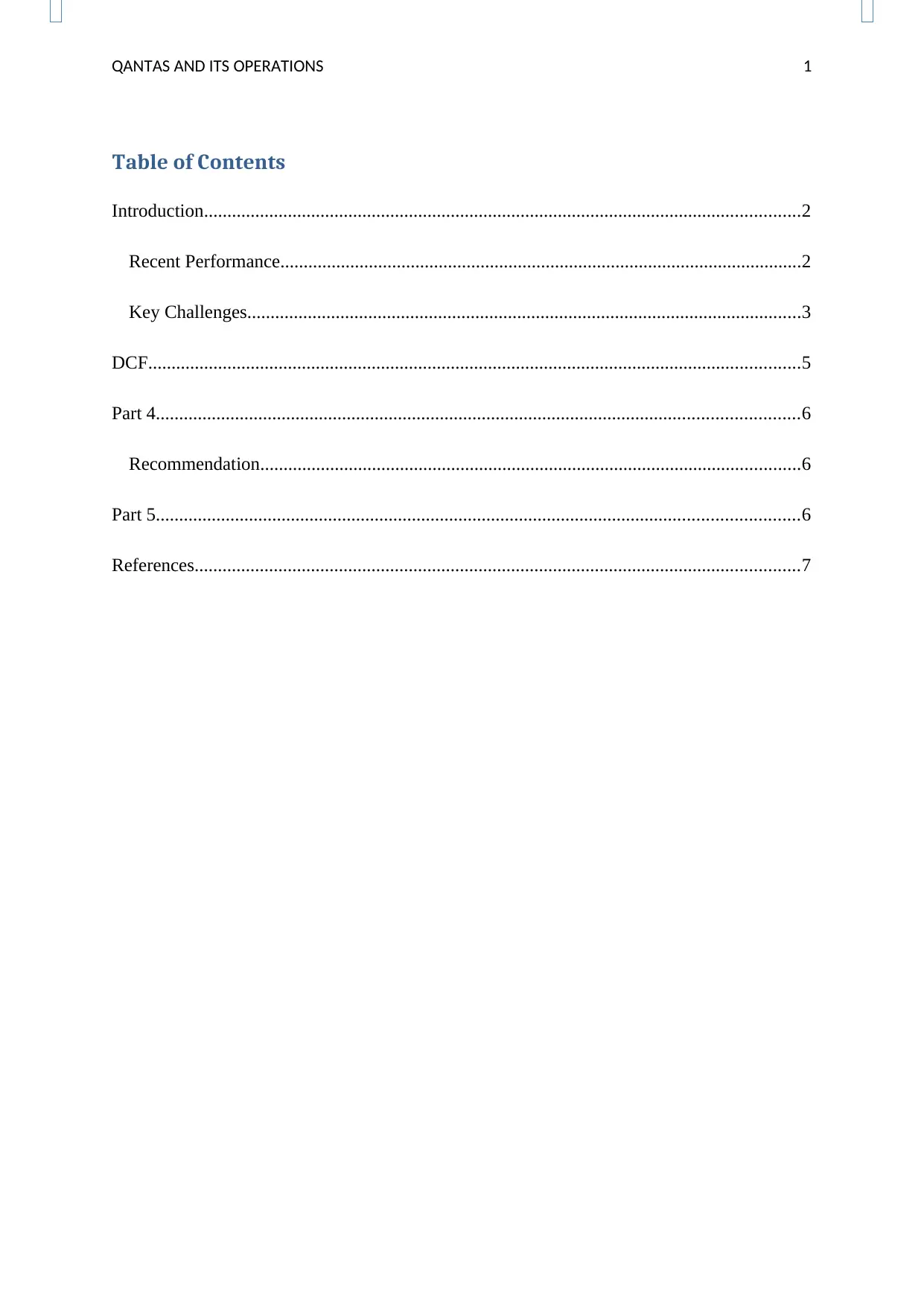
QANTAS AND ITS OPERATIONS 1
Table of Contents
Introduction................................................................................................................................2
Recent Performance................................................................................................................2
Key Challenges.......................................................................................................................3
DCF............................................................................................................................................5
Part 4..........................................................................................................................................6
Recommendation....................................................................................................................6
Part 5..........................................................................................................................................6
References..................................................................................................................................7
Table of Contents
Introduction................................................................................................................................2
Recent Performance................................................................................................................2
Key Challenges.......................................................................................................................3
DCF............................................................................................................................................5
Part 4..........................................................................................................................................6
Recommendation....................................................................................................................6
Part 5..........................................................................................................................................6
References..................................................................................................................................7
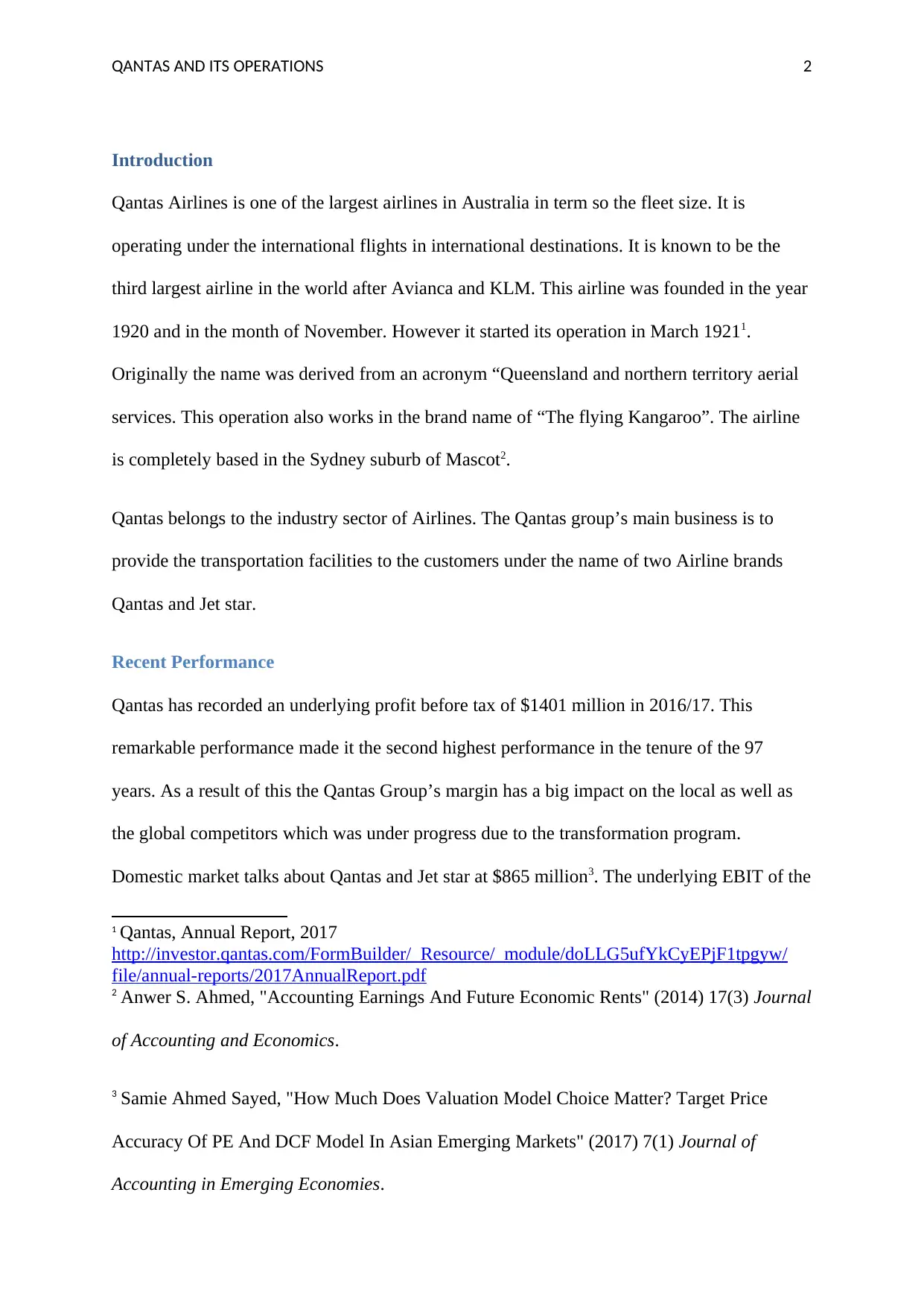
QANTAS AND ITS OPERATIONS 2
Introduction
Qantas Airlines is one of the largest airlines in Australia in term so the fleet size. It is
operating under the international flights in international destinations. It is known to be the
third largest airline in the world after Avianca and KLM. This airline was founded in the year
1920 and in the month of November. However it started its operation in March 19211.
Originally the name was derived from an acronym “Queensland and northern territory aerial
services. This operation also works in the brand name of “The flying Kangaroo”. The airline
is completely based in the Sydney suburb of Mascot2.
Qantas belongs to the industry sector of Airlines. The Qantas group’s main business is to
provide the transportation facilities to the customers under the name of two Airline brands
Qantas and Jet star.
Recent Performance
Qantas has recorded an underlying profit before tax of $1401 million in 2016/17. This
remarkable performance made it the second highest performance in the tenure of the 97
years. As a result of this the Qantas Group’s margin has a big impact on the local as well as
the global competitors which was under progress due to the transformation program.
Domestic market talks about Qantas and Jet star at $865 million3. The underlying EBIT of the
1 Qantas, Annual Report, 2017
http://investor.qantas.com/FormBuilder/_Resource/_module/doLLG5ufYkCyEPjF1tpgyw/
file/annual-reports/2017AnnualReport.pdf
2 Anwer S. Ahmed, "Accounting Earnings And Future Economic Rents" (2014) 17(3) Journal
of Accounting and Economics.
3 Samie Ahmed Sayed, "How Much Does Valuation Model Choice Matter? Target Price
Accuracy Of PE And DCF Model In Asian Emerging Markets" (2017) 7(1) Journal of
Accounting in Emerging Economies.
Introduction
Qantas Airlines is one of the largest airlines in Australia in term so the fleet size. It is
operating under the international flights in international destinations. It is known to be the
third largest airline in the world after Avianca and KLM. This airline was founded in the year
1920 and in the month of November. However it started its operation in March 19211.
Originally the name was derived from an acronym “Queensland and northern territory aerial
services. This operation also works in the brand name of “The flying Kangaroo”. The airline
is completely based in the Sydney suburb of Mascot2.
Qantas belongs to the industry sector of Airlines. The Qantas group’s main business is to
provide the transportation facilities to the customers under the name of two Airline brands
Qantas and Jet star.
Recent Performance
Qantas has recorded an underlying profit before tax of $1401 million in 2016/17. This
remarkable performance made it the second highest performance in the tenure of the 97
years. As a result of this the Qantas Group’s margin has a big impact on the local as well as
the global competitors which was under progress due to the transformation program.
Domestic market talks about Qantas and Jet star at $865 million3. The underlying EBIT of the
1 Qantas, Annual Report, 2017
http://investor.qantas.com/FormBuilder/_Resource/_module/doLLG5ufYkCyEPjF1tpgyw/
file/annual-reports/2017AnnualReport.pdf
2 Anwer S. Ahmed, "Accounting Earnings And Future Economic Rents" (2014) 17(3) Journal
of Accounting and Economics.
3 Samie Ahmed Sayed, "How Much Does Valuation Model Choice Matter? Target Price
Accuracy Of PE And DCF Model In Asian Emerging Markets" (2017) 7(1) Journal of
Accounting in Emerging Economies.
⊘ This is a preview!⊘
Do you want full access?
Subscribe today to unlock all pages.

Trusted by 1+ million students worldwide
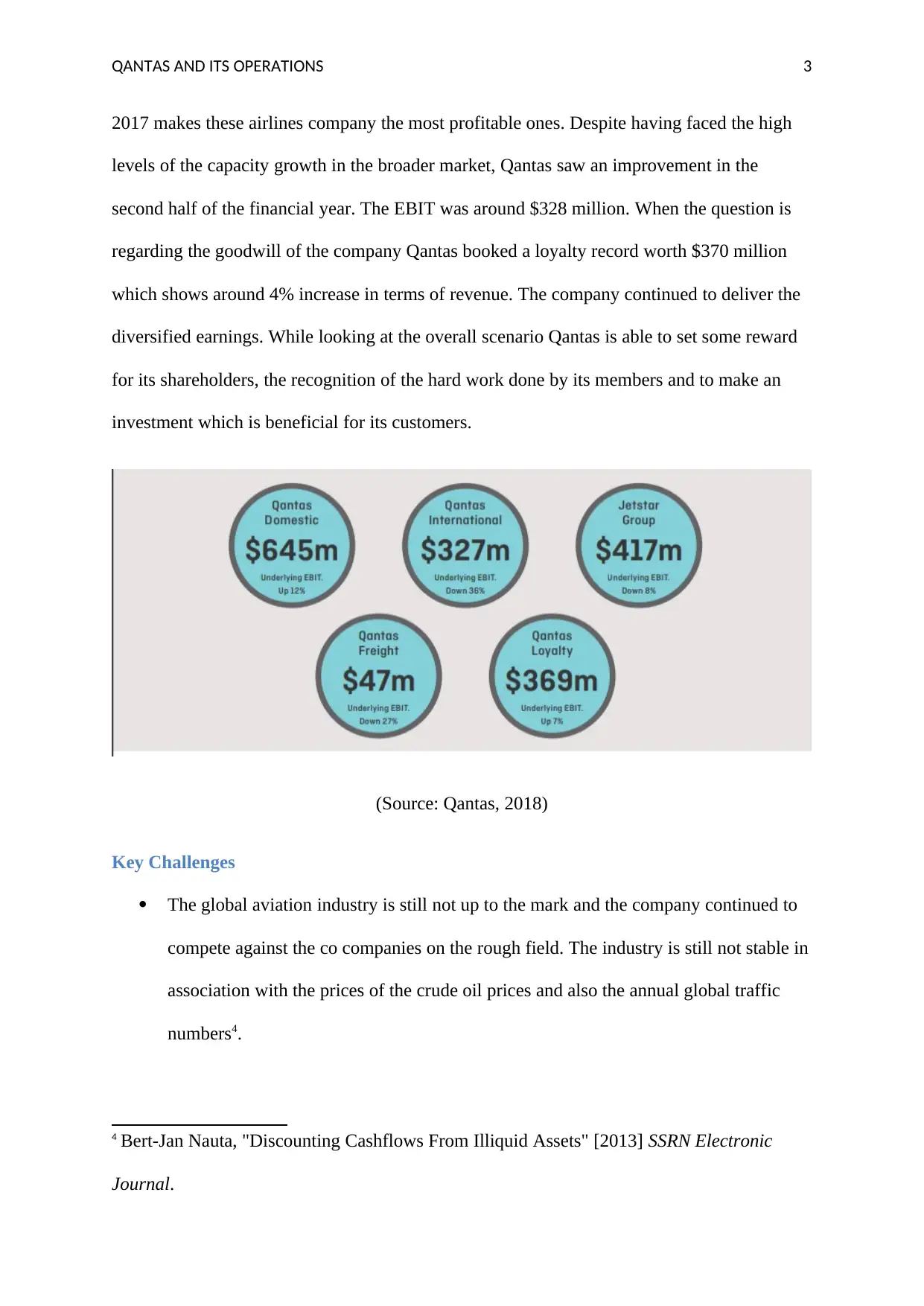
QANTAS AND ITS OPERATIONS 3
2017 makes these airlines company the most profitable ones. Despite having faced the high
levels of the capacity growth in the broader market, Qantas saw an improvement in the
second half of the financial year. The EBIT was around $328 million. When the question is
regarding the goodwill of the company Qantas booked a loyalty record worth $370 million
which shows around 4% increase in terms of revenue. The company continued to deliver the
diversified earnings. While looking at the overall scenario Qantas is able to set some reward
for its shareholders, the recognition of the hard work done by its members and to make an
investment which is beneficial for its customers.
(Source: Qantas, 2018)
Key Challenges
The global aviation industry is still not up to the mark and the company continued to
compete against the co companies on the rough field. The industry is still not stable in
association with the prices of the crude oil prices and also the annual global traffic
numbers4.
4 Bert-Jan Nauta, "Discounting Cashflows From Illiquid Assets" [2013] SSRN Electronic
Journal.
2017 makes these airlines company the most profitable ones. Despite having faced the high
levels of the capacity growth in the broader market, Qantas saw an improvement in the
second half of the financial year. The EBIT was around $328 million. When the question is
regarding the goodwill of the company Qantas booked a loyalty record worth $370 million
which shows around 4% increase in terms of revenue. The company continued to deliver the
diversified earnings. While looking at the overall scenario Qantas is able to set some reward
for its shareholders, the recognition of the hard work done by its members and to make an
investment which is beneficial for its customers.
(Source: Qantas, 2018)
Key Challenges
The global aviation industry is still not up to the mark and the company continued to
compete against the co companies on the rough field. The industry is still not stable in
association with the prices of the crude oil prices and also the annual global traffic
numbers4.
4 Bert-Jan Nauta, "Discounting Cashflows From Illiquid Assets" [2013] SSRN Electronic
Journal.
Paraphrase This Document
Need a fresh take? Get an instant paraphrase of this document with our AI Paraphraser
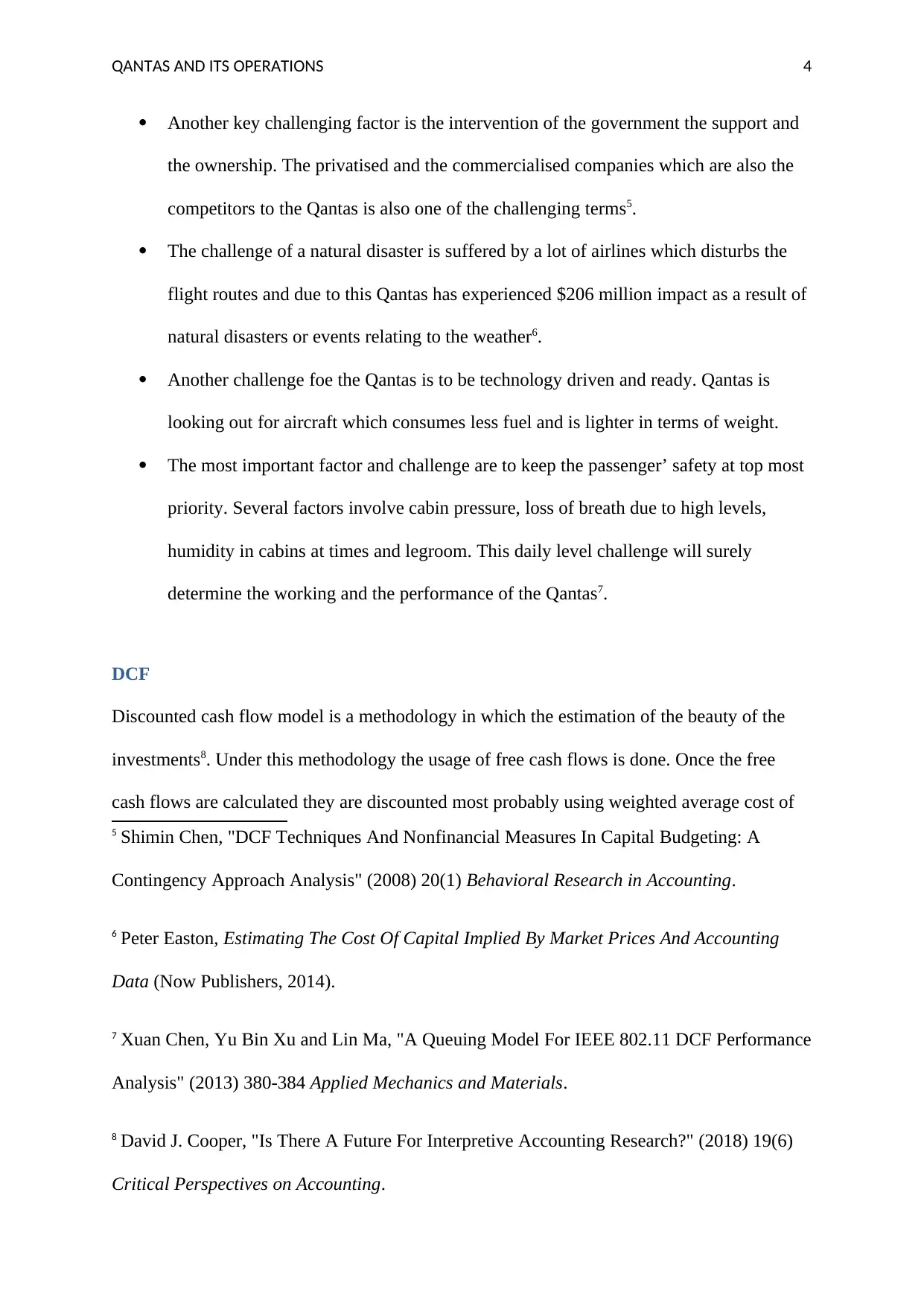
QANTAS AND ITS OPERATIONS 4
Another key challenging factor is the intervention of the government the support and
the ownership. The privatised and the commercialised companies which are also the
competitors to the Qantas is also one of the challenging terms5.
The challenge of a natural disaster is suffered by a lot of airlines which disturbs the
flight routes and due to this Qantas has experienced $206 million impact as a result of
natural disasters or events relating to the weather6.
Another challenge foe the Qantas is to be technology driven and ready. Qantas is
looking out for aircraft which consumes less fuel and is lighter in terms of weight.
The most important factor and challenge are to keep the passenger’ safety at top most
priority. Several factors involve cabin pressure, loss of breath due to high levels,
humidity in cabins at times and legroom. This daily level challenge will surely
determine the working and the performance of the Qantas7.
DCF
Discounted cash flow model is a methodology in which the estimation of the beauty of the
investments8. Under this methodology the usage of free cash flows is done. Once the free
cash flows are calculated they are discounted most probably using weighted average cost of
5 Shimin Chen, "DCF Techniques And Nonfinancial Measures In Capital Budgeting: A
Contingency Approach Analysis" (2008) 20(1) Behavioral Research in Accounting.
6 Peter Easton, Estimating The Cost Of Capital Implied By Market Prices And Accounting
Data (Now Publishers, 2014).
7 Xuan Chen, Yu Bin Xu and Lin Ma, "A Queuing Model For IEEE 802.11 DCF Performance
Analysis" (2013) 380-384 Applied Mechanics and Materials.
8 David J. Cooper, "Is There A Future For Interpretive Accounting Research?" (2018) 19(6)
Critical Perspectives on Accounting.
Another key challenging factor is the intervention of the government the support and
the ownership. The privatised and the commercialised companies which are also the
competitors to the Qantas is also one of the challenging terms5.
The challenge of a natural disaster is suffered by a lot of airlines which disturbs the
flight routes and due to this Qantas has experienced $206 million impact as a result of
natural disasters or events relating to the weather6.
Another challenge foe the Qantas is to be technology driven and ready. Qantas is
looking out for aircraft which consumes less fuel and is lighter in terms of weight.
The most important factor and challenge are to keep the passenger’ safety at top most
priority. Several factors involve cabin pressure, loss of breath due to high levels,
humidity in cabins at times and legroom. This daily level challenge will surely
determine the working and the performance of the Qantas7.
DCF
Discounted cash flow model is a methodology in which the estimation of the beauty of the
investments8. Under this methodology the usage of free cash flows is done. Once the free
cash flows are calculated they are discounted most probably using weighted average cost of
5 Shimin Chen, "DCF Techniques And Nonfinancial Measures In Capital Budgeting: A
Contingency Approach Analysis" (2008) 20(1) Behavioral Research in Accounting.
6 Peter Easton, Estimating The Cost Of Capital Implied By Market Prices And Accounting
Data (Now Publishers, 2014).
7 Xuan Chen, Yu Bin Xu and Lin Ma, "A Queuing Model For IEEE 802.11 DCF Performance
Analysis" (2013) 380-384 Applied Mechanics and Materials.
8 David J. Cooper, "Is There A Future For Interpretive Accounting Research?" (2018) 19(6)
Critical Perspectives on Accounting.
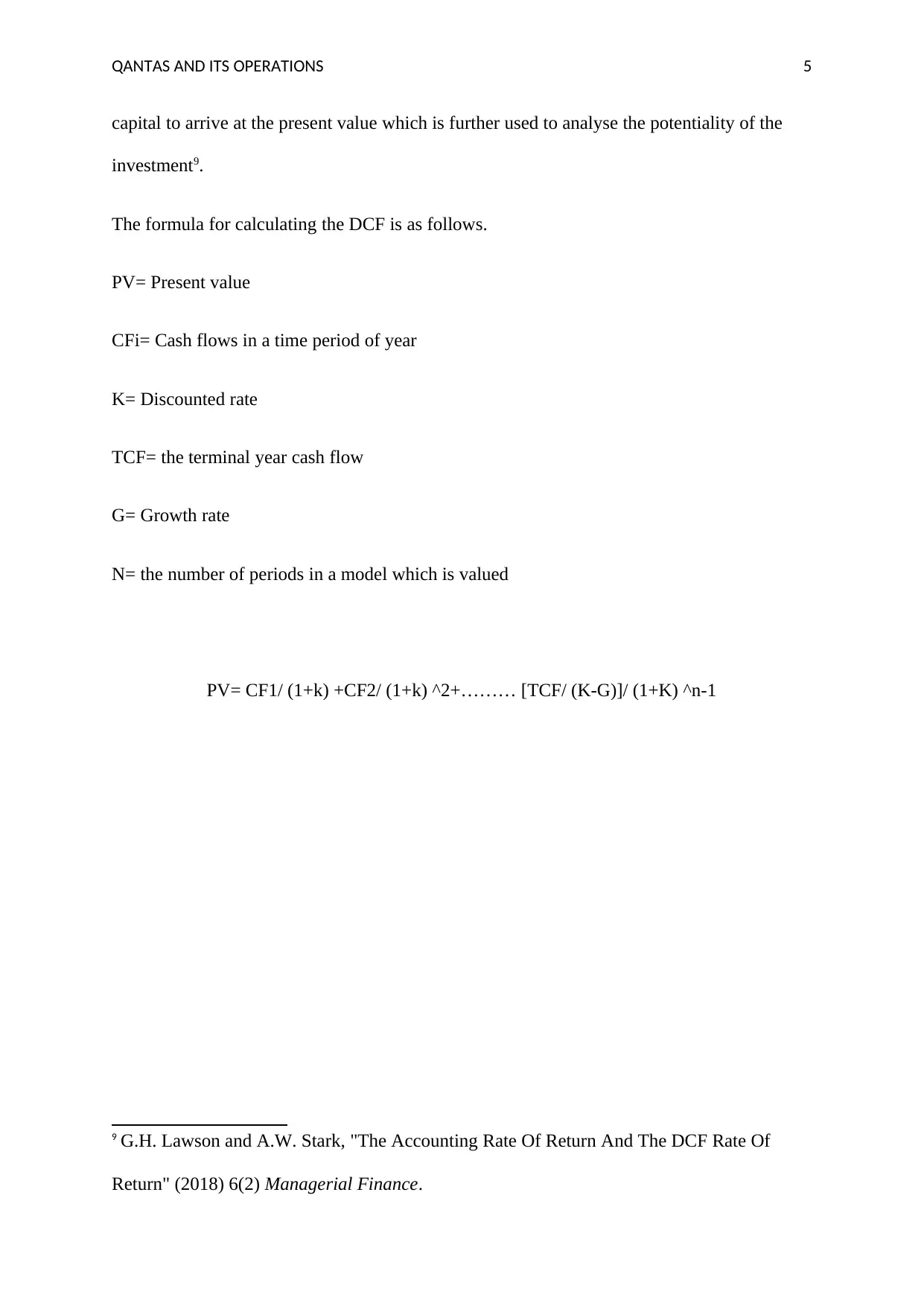
QANTAS AND ITS OPERATIONS 5
capital to arrive at the present value which is further used to analyse the potentiality of the
investment9.
The formula for calculating the DCF is as follows.
PV= Present value
CFi= Cash flows in a time period of year
K= Discounted rate
TCF= the terminal year cash flow
G= Growth rate
N= the number of periods in a model which is valued
PV= CF1/ (1+k) +CF2/ (1+k) ^2+……… [TCF/ (K-G)]/ (1+K) ^n-1
9 G.H. Lawson and A.W. Stark, "The Accounting Rate Of Return And The DCF Rate Of
Return" (2018) 6(2) Managerial Finance.
capital to arrive at the present value which is further used to analyse the potentiality of the
investment9.
The formula for calculating the DCF is as follows.
PV= Present value
CFi= Cash flows in a time period of year
K= Discounted rate
TCF= the terminal year cash flow
G= Growth rate
N= the number of periods in a model which is valued
PV= CF1/ (1+k) +CF2/ (1+k) ^2+……… [TCF/ (K-G)]/ (1+K) ^n-1
9 G.H. Lawson and A.W. Stark, "The Accounting Rate Of Return And The DCF Rate Of
Return" (2018) 6(2) Managerial Finance.
⊘ This is a preview!⊘
Do you want full access?
Subscribe today to unlock all pages.

Trusted by 1+ million students worldwide
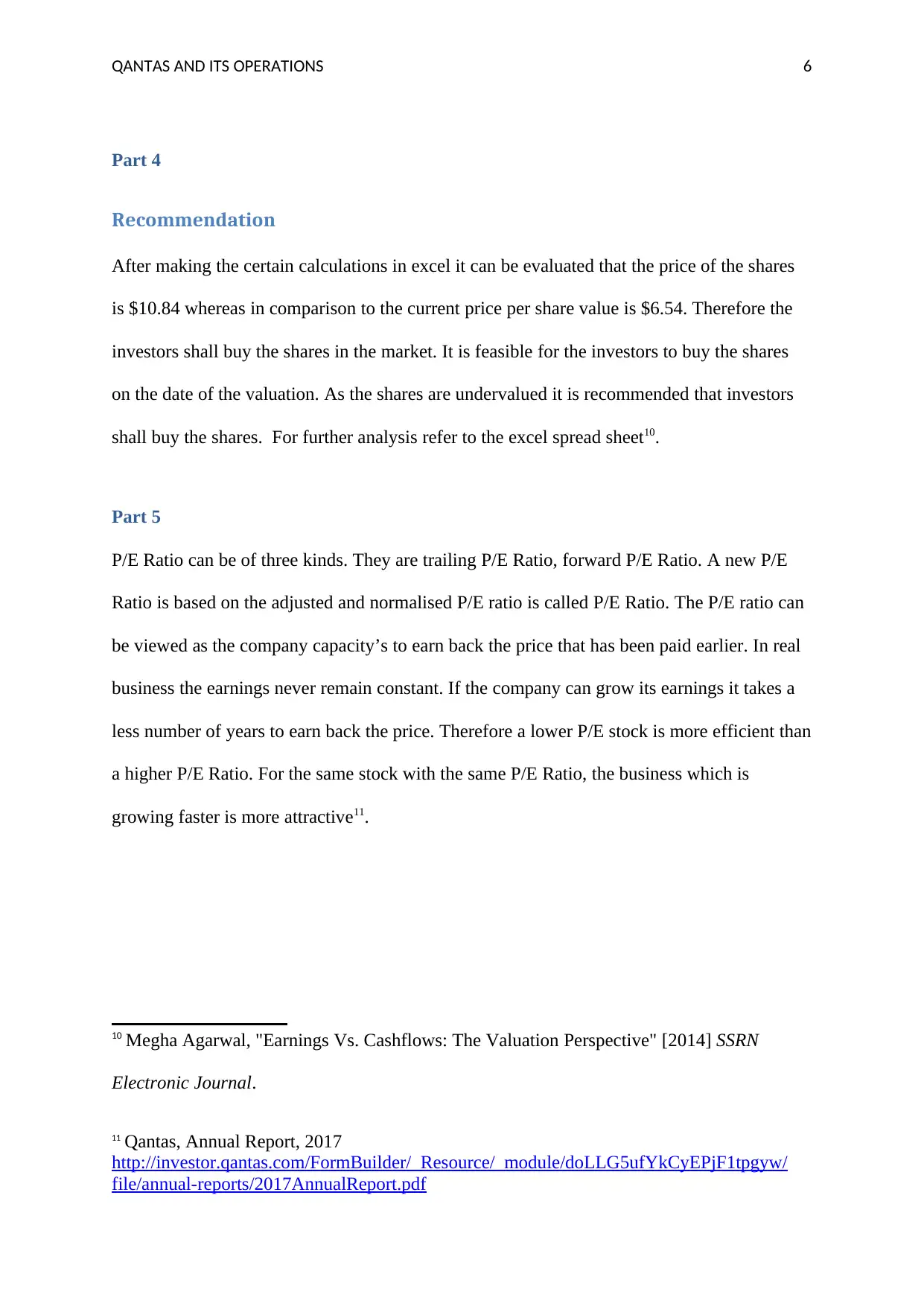
QANTAS AND ITS OPERATIONS 6
Part 4
Recommendation
After making the certain calculations in excel it can be evaluated that the price of the shares
is $10.84 whereas in comparison to the current price per share value is $6.54. Therefore the
investors shall buy the shares in the market. It is feasible for the investors to buy the shares
on the date of the valuation. As the shares are undervalued it is recommended that investors
shall buy the shares. For further analysis refer to the excel spread sheet10.
Part 5
P/E Ratio can be of three kinds. They are trailing P/E Ratio, forward P/E Ratio. A new P/E
Ratio is based on the adjusted and normalised P/E ratio is called P/E Ratio. The P/E ratio can
be viewed as the company capacity’s to earn back the price that has been paid earlier. In real
business the earnings never remain constant. If the company can grow its earnings it takes a
less number of years to earn back the price. Therefore a lower P/E stock is more efficient than
a higher P/E Ratio. For the same stock with the same P/E Ratio, the business which is
growing faster is more attractive11.
10 Megha Agarwal, "Earnings Vs. Cashflows: The Valuation Perspective" [2014] SSRN
Electronic Journal.
11 Qantas, Annual Report, 2017
http://investor.qantas.com/FormBuilder/_Resource/_module/doLLG5ufYkCyEPjF1tpgyw/
file/annual-reports/2017AnnualReport.pdf
Part 4
Recommendation
After making the certain calculations in excel it can be evaluated that the price of the shares
is $10.84 whereas in comparison to the current price per share value is $6.54. Therefore the
investors shall buy the shares in the market. It is feasible for the investors to buy the shares
on the date of the valuation. As the shares are undervalued it is recommended that investors
shall buy the shares. For further analysis refer to the excel spread sheet10.
Part 5
P/E Ratio can be of three kinds. They are trailing P/E Ratio, forward P/E Ratio. A new P/E
Ratio is based on the adjusted and normalised P/E ratio is called P/E Ratio. The P/E ratio can
be viewed as the company capacity’s to earn back the price that has been paid earlier. In real
business the earnings never remain constant. If the company can grow its earnings it takes a
less number of years to earn back the price. Therefore a lower P/E stock is more efficient than
a higher P/E Ratio. For the same stock with the same P/E Ratio, the business which is
growing faster is more attractive11.
10 Megha Agarwal, "Earnings Vs. Cashflows: The Valuation Perspective" [2014] SSRN
Electronic Journal.
11 Qantas, Annual Report, 2017
http://investor.qantas.com/FormBuilder/_Resource/_module/doLLG5ufYkCyEPjF1tpgyw/
file/annual-reports/2017AnnualReport.pdf
Paraphrase This Document
Need a fresh take? Get an instant paraphrase of this document with our AI Paraphraser
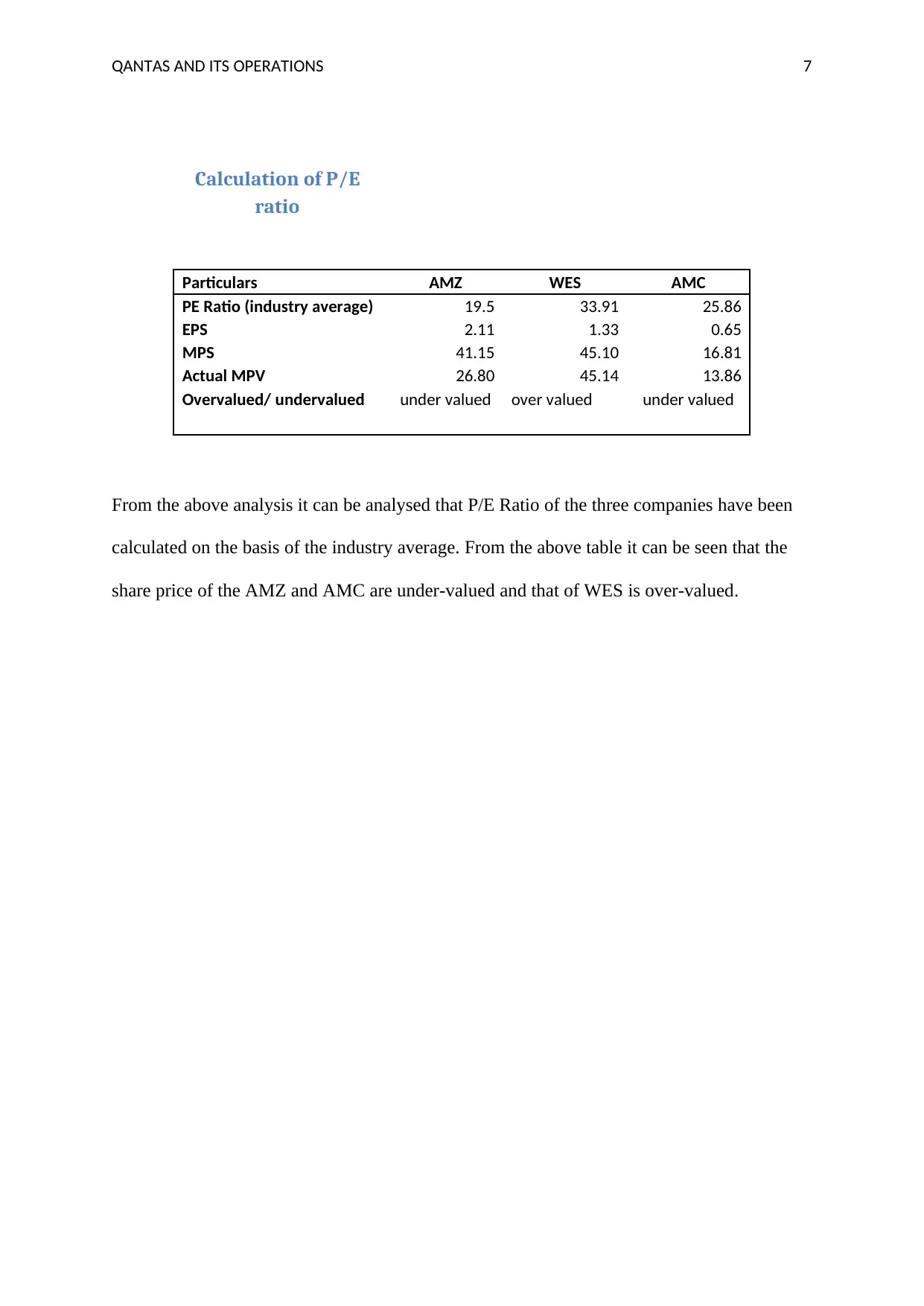
QANTAS AND ITS OPERATIONS 7
Calculation of P/E
ratio
Particulars AMZ WES AMC
PE Ratio (industry average) 19.5 33.91 25.86
EPS 2.11 1.33 0.65
MPS 41.15 45.10 16.81
Actual MPV 26.80 45.14 13.86
Overvalued/ undervalued under valued over valued under valued
From the above analysis it can be analysed that P/E Ratio of the three companies have been
calculated on the basis of the industry average. From the above table it can be seen that the
share price of the AMZ and AMC are under-valued and that of WES is over-valued.
Calculation of P/E
ratio
Particulars AMZ WES AMC
PE Ratio (industry average) 19.5 33.91 25.86
EPS 2.11 1.33 0.65
MPS 41.15 45.10 16.81
Actual MPV 26.80 45.14 13.86
Overvalued/ undervalued under valued over valued under valued
From the above analysis it can be analysed that P/E Ratio of the three companies have been
calculated on the basis of the industry average. From the above table it can be seen that the
share price of the AMZ and AMC are under-valued and that of WES is over-valued.
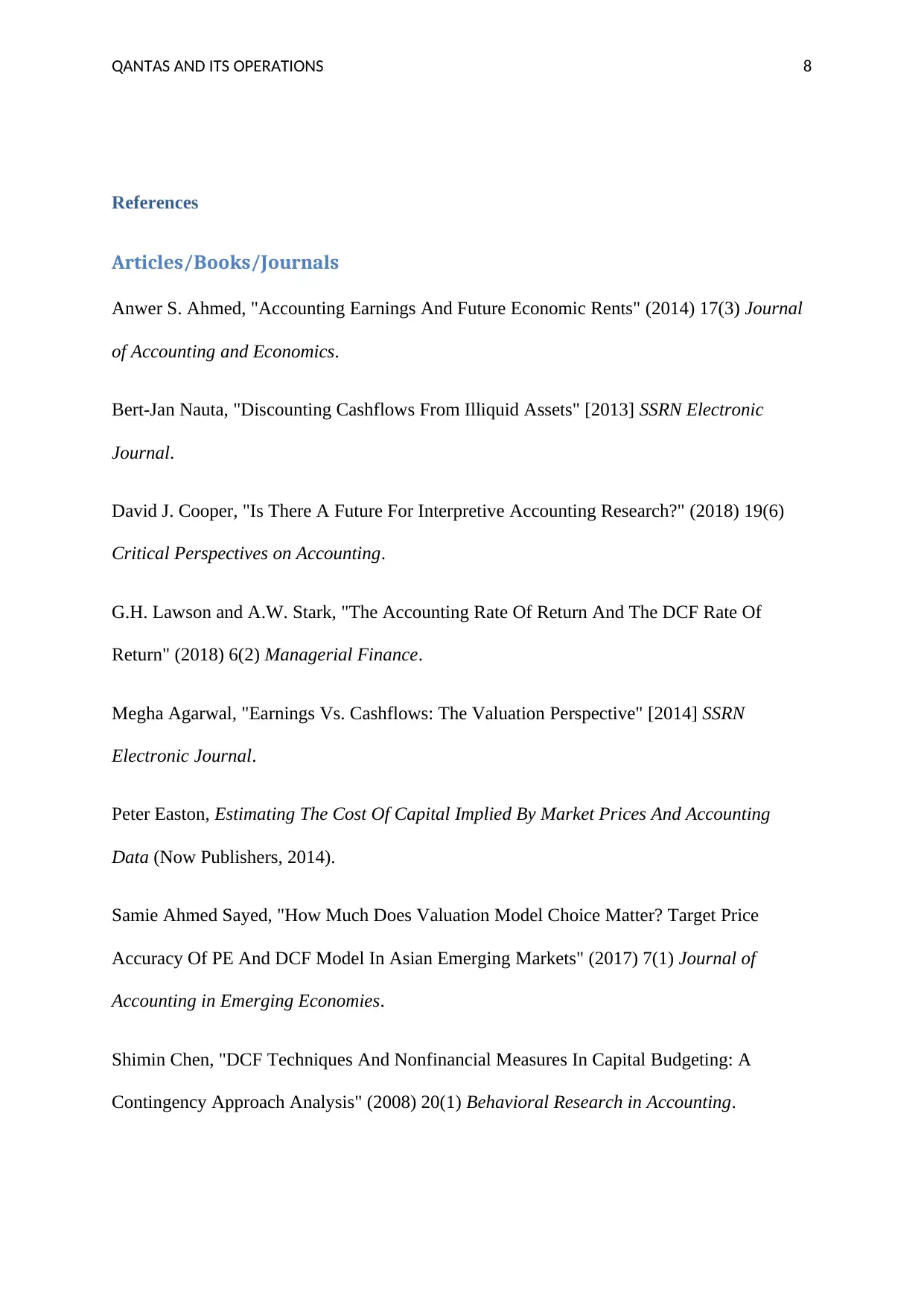
QANTAS AND ITS OPERATIONS 8
References
Articles/Books/Journals
Anwer S. Ahmed, "Accounting Earnings And Future Economic Rents" (2014) 17(3) Journal
of Accounting and Economics.
Bert-Jan Nauta, "Discounting Cashflows From Illiquid Assets" [2013] SSRN Electronic
Journal.
David J. Cooper, "Is There A Future For Interpretive Accounting Research?" (2018) 19(6)
Critical Perspectives on Accounting.
G.H. Lawson and A.W. Stark, "The Accounting Rate Of Return And The DCF Rate Of
Return" (2018) 6(2) Managerial Finance.
Megha Agarwal, "Earnings Vs. Cashflows: The Valuation Perspective" [2014] SSRN
Electronic Journal.
Peter Easton, Estimating The Cost Of Capital Implied By Market Prices And Accounting
Data (Now Publishers, 2014).
Samie Ahmed Sayed, "How Much Does Valuation Model Choice Matter? Target Price
Accuracy Of PE And DCF Model In Asian Emerging Markets" (2017) 7(1) Journal of
Accounting in Emerging Economies.
Shimin Chen, "DCF Techniques And Nonfinancial Measures In Capital Budgeting: A
Contingency Approach Analysis" (2008) 20(1) Behavioral Research in Accounting.
References
Articles/Books/Journals
Anwer S. Ahmed, "Accounting Earnings And Future Economic Rents" (2014) 17(3) Journal
of Accounting and Economics.
Bert-Jan Nauta, "Discounting Cashflows From Illiquid Assets" [2013] SSRN Electronic
Journal.
David J. Cooper, "Is There A Future For Interpretive Accounting Research?" (2018) 19(6)
Critical Perspectives on Accounting.
G.H. Lawson and A.W. Stark, "The Accounting Rate Of Return And The DCF Rate Of
Return" (2018) 6(2) Managerial Finance.
Megha Agarwal, "Earnings Vs. Cashflows: The Valuation Perspective" [2014] SSRN
Electronic Journal.
Peter Easton, Estimating The Cost Of Capital Implied By Market Prices And Accounting
Data (Now Publishers, 2014).
Samie Ahmed Sayed, "How Much Does Valuation Model Choice Matter? Target Price
Accuracy Of PE And DCF Model In Asian Emerging Markets" (2017) 7(1) Journal of
Accounting in Emerging Economies.
Shimin Chen, "DCF Techniques And Nonfinancial Measures In Capital Budgeting: A
Contingency Approach Analysis" (2008) 20(1) Behavioral Research in Accounting.
⊘ This is a preview!⊘
Do you want full access?
Subscribe today to unlock all pages.

Trusted by 1+ million students worldwide
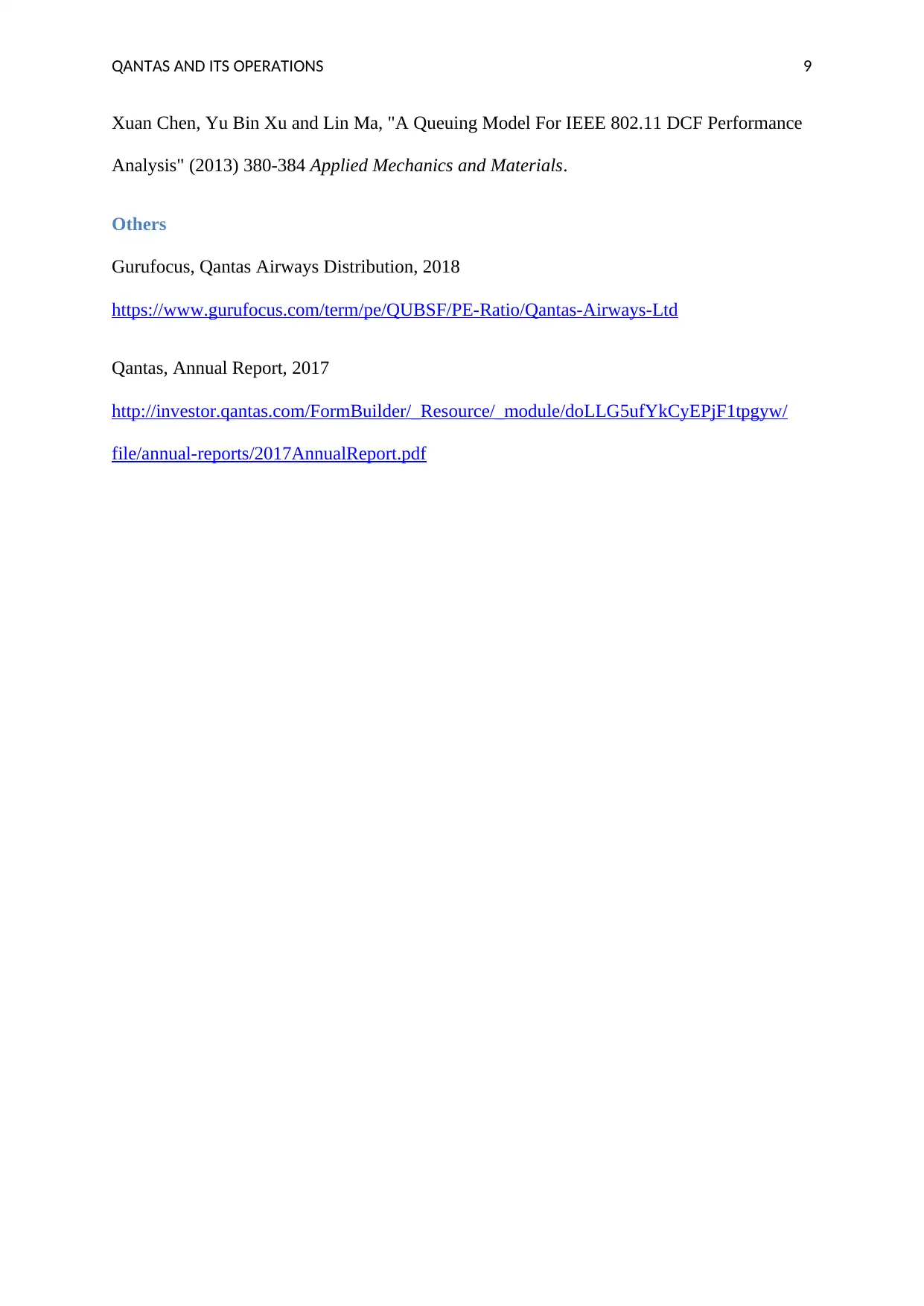
QANTAS AND ITS OPERATIONS 9
Xuan Chen, Yu Bin Xu and Lin Ma, "A Queuing Model For IEEE 802.11 DCF Performance
Analysis" (2013) 380-384 Applied Mechanics and Materials.
Others
Gurufocus, Qantas Airways Distribution, 2018
https://www.gurufocus.com/term/pe/QUBSF/PE-Ratio/Qantas-Airways-Ltd
Qantas, Annual Report, 2017
http://investor.qantas.com/FormBuilder/_Resource/_module/doLLG5ufYkCyEPjF1tpgyw/
file/annual-reports/2017AnnualReport.pdf
Xuan Chen, Yu Bin Xu and Lin Ma, "A Queuing Model For IEEE 802.11 DCF Performance
Analysis" (2013) 380-384 Applied Mechanics and Materials.
Others
Gurufocus, Qantas Airways Distribution, 2018
https://www.gurufocus.com/term/pe/QUBSF/PE-Ratio/Qantas-Airways-Ltd
Qantas, Annual Report, 2017
http://investor.qantas.com/FormBuilder/_Resource/_module/doLLG5ufYkCyEPjF1tpgyw/
file/annual-reports/2017AnnualReport.pdf
1 out of 10
Related Documents
Your All-in-One AI-Powered Toolkit for Academic Success.
+13062052269
info@desklib.com
Available 24*7 on WhatsApp / Email
![[object Object]](/_next/static/media/star-bottom.7253800d.svg)
Unlock your academic potential
Copyright © 2020–2025 A2Z Services. All Rights Reserved. Developed and managed by ZUCOL.




